Permeability and Stiffness Assessment of Paved and Unpaved Roads with Geocomposite Drainage Layers
Abstract
:1. Introduction
2. Descriptions of Materials and Test Sections
3. Test Methods
3.1. Laboratory Large-Scale Horizontal Permeameter Test (HPT)
3.2. Core-Hole Permeameter (CHP) Test
3.3. Air Permeameter Test (APT)
3.4. Falling Weight Deflectometer (FWD) Test
4. Laboratory Horizontal Permeameter Test (HPT) Results
5. In Situ Permeability and Stiffness of The Test Sections
5.1. In Situ Permeability Assessment
5.2. In Situ Stiffness Assessment
6. Numerical Simulation of Drainage Performance under Heavy Rainfall
7. Summary and Conclusions
Acknowledgments
Author Contributions
Conflicts of Interest
References
- Han, J. Design of Planar Geosynthetic-Improved Unpaved and Paved Roads. In First International Symposium on Pavement and Geotechnical Engineering for Transportation Infrastructure; Huang, B., Bowers, B.F., Mei, G.-X., Luo, S.-H., Zhang, Z., Eds.; American Society of Civil Engineers (ASCE): Nanchang, China, 2011; pp. 31–41. [Google Scholar]
- Holtz, R.D.; Christopher, B.R.; Berg, R.R. Geosynthetic design and construction guidelines. In Highway Capacity Manual: A Guide for Multimodal Mobility Analysis, 6th ed.; Federal Highway Administration, U.S. Department of Transportation: Washington, DC, USA, 2008; p. 592. [Google Scholar]
- Bahador, M.; Evans, T.M.; Gabr, M.A. Modeling effect of geocomposite drainage layers on moisture distribution and plastic deformation of road sections. J. Geotech. Geoenviron. Eng. 2013, 139, 1407–1418. [Google Scholar] [CrossRef]
- Christopher, B.R.; Hayden, S.A.; Zhao, A. Roadway base and subgrade geocomposite drainage layers. In The Symposium of ‘Testing and Performance of Geosynthetics in Subsurface Drainage; ASTM: Seattle, WA, USA, 2000; pp. 35–51. [Google Scholar]
- Henry, K.S.; Holtz, R.D. Geocomposite Capillary Barriers to Reduce Frost Heave in Soils. Can. Geotech. J. 2001, 38, 678–694. [Google Scholar] [CrossRef]
- Stormont, J.C.; Ramos, R.; Henry, K.S. Geocomposite Capillary Barrier Drain Systems with Fiberglass Transport Layer. Transp. Res. Rec. J. Transp. Res. Board 2001, 1772, 131–136. [Google Scholar] [CrossRef]
- Sweet, J.G. Vertical Stiffness Characterization of a Geocomposite Drainage Layer for PCC Highway Pavements. Master’s Thesis, West Virginia University, Morgantown, WV, USA, 2005. [Google Scholar]
- AASHTO. Geotextile Specification for Highway Applications. In Standard Specifications for Transportation Materials and Methods of Sampling and Testing, AASHTO M 288; American Association of State Highway and Transportation Officials: Washington, DC, USA, 2014. [Google Scholar]
- ASTM. Standard Test Method for Breaking Force and Elongation of Textile Fabrics (Strip Method). In Annual Book of ASTM Standards ASTM D5035-11; ASTM International: West Conshohocken, PA, USA, 2013. [Google Scholar]
- ASTM. Standard Test Methods for Water Permeability of Geotextiles by Permittivity. In Annual Book of ASTM Standards ASTM D4491-99; ASTM International: West Conshohocken, PA, USA, 2013. [Google Scholar]
- ASTM. Standard Test Methods for Determining Apparent Opening Size of a Geotextile. In Annual Book of ASTM Standards ASTM D4751-12; ASTM International: West Conshohocken, PA, USA, 2013. [Google Scholar]
- White, D.J.; Becker, P.; Vennapusa, P.K.; Dunn, M.J.; White, C.I. Assessing Soil Stiffness of Stabilized Pavement Foundations. Transp. Res. Rec. J. Transp. Res. 2013, 2335, 99–109. [Google Scholar] [CrossRef]
- White, D.J.; Vennapusa, P.K.; Becker, P.J.; Zhang, Y.; Dunn, M.J. Performance Assessment of Cement Stabilized, Polymer Fiber-Reinforced Pavement Foundation Layers. In Proceedings of the Geosynthetics Conference, Portland, OR, USA, 15–18 February 2015. [Google Scholar]
- Li, C.; Ashlock, J.C.; White, D.J.; Vennapusa, P. Mechanistic-based comparisons of stabilised base and granular surface layers of low-volume roads. Int. J. Pavement Eng. 2017. [Google Scholar] [CrossRef]
- ASTM. Standard Test Methods for Laboratory Compaction Characteristics of Soil Using Standard Effort (12,400 ft-lbf/ft3 (600 kN-m/m3)). In Annual Book of ASTM Standards ASTM D698-07; ASTM International: West Conshohocken, PA, USA, 2013. [Google Scholar]
- ASTM. Standard Test Method for Field Measurement of Hydraulic Conductivity Using Borehole Infiltration. In Annual Book of ASTM Standards ASTM D6391-11; ASTM International: West Conshohocken, PA, USA, 2013. [Google Scholar]
- Vennapusa, P.; White, D.J.; Jahren, C.T. In-Situ Permeability of Unbound Granular Bases Using the Air Permeameter Test. In Proceedings of the 85th Annual Transportation Research Board Conference, Washington, DC, USA, 22–26 January 2006. [Google Scholar]
- Zhang, J.; White, D.; Taylor, P.C.; Shi, C. A case study of evaluating joint performance in relation with subsurface permeability in cold weather region. Cold Reg. Sci. Technol. 2015, 110, 19–25. [Google Scholar] [CrossRef]
- White, D.J.; Vennapusa, P.K.R.; Suleiman, M.T.; Dahren, C.T. An in-situ device for rapid determination of permeability for granular bases. Geotech. Test. J. 2007, 30, 282–291. [Google Scholar]
- White, D.J.; Vennapusa, P.; Zhao, L. Verification and repeatability analysis for the in situ air permeameter test. Geotech. Test. J. 2014, 37, 365–376. [Google Scholar] [CrossRef]
- AASHTO. AASHTO Guide for Design of Pavement Structures; American Association of State Highway and Transportation Officials: Washington, DC, USA, 1993. [Google Scholar]
- Haverkamp, R.; Vauclin, M.; Touma, J.; Wierenga, P.J.; Vachaud, G. A Comparison of Numerical Simulation Models for One-Dimensional Infiltration. Soil Sci. Soc. Am. J. 1977, 41, 285–294. [Google Scholar] [CrossRef]
- Jury, W.A.; Horton, R. Soil Physics, 6th ed.; John Wiley & Sons: Hoboken, NJ, USA, 2004. [Google Scholar]
- ASTM. Standard Test Method for Measurement of Hydraulic Conductivity of Porous Material Using a Rigid-Wall, Compaction-Mold Permeameter. In Annual Book of ASTM Standards ASTM D5856-07; ASTM International: West Conshohocken, PA, USA, 2013. [Google Scholar]
- Li, C.; Ashlock, J.C.; White, D.J.; Vennapusa, P. Low-Cost Rural Surface Alternatives: Demonstration Project; Iowa Highway Research Board (IHRB) Project TR-664; Iowa State University: Ames, IA, USA, 2015. [Google Scholar]
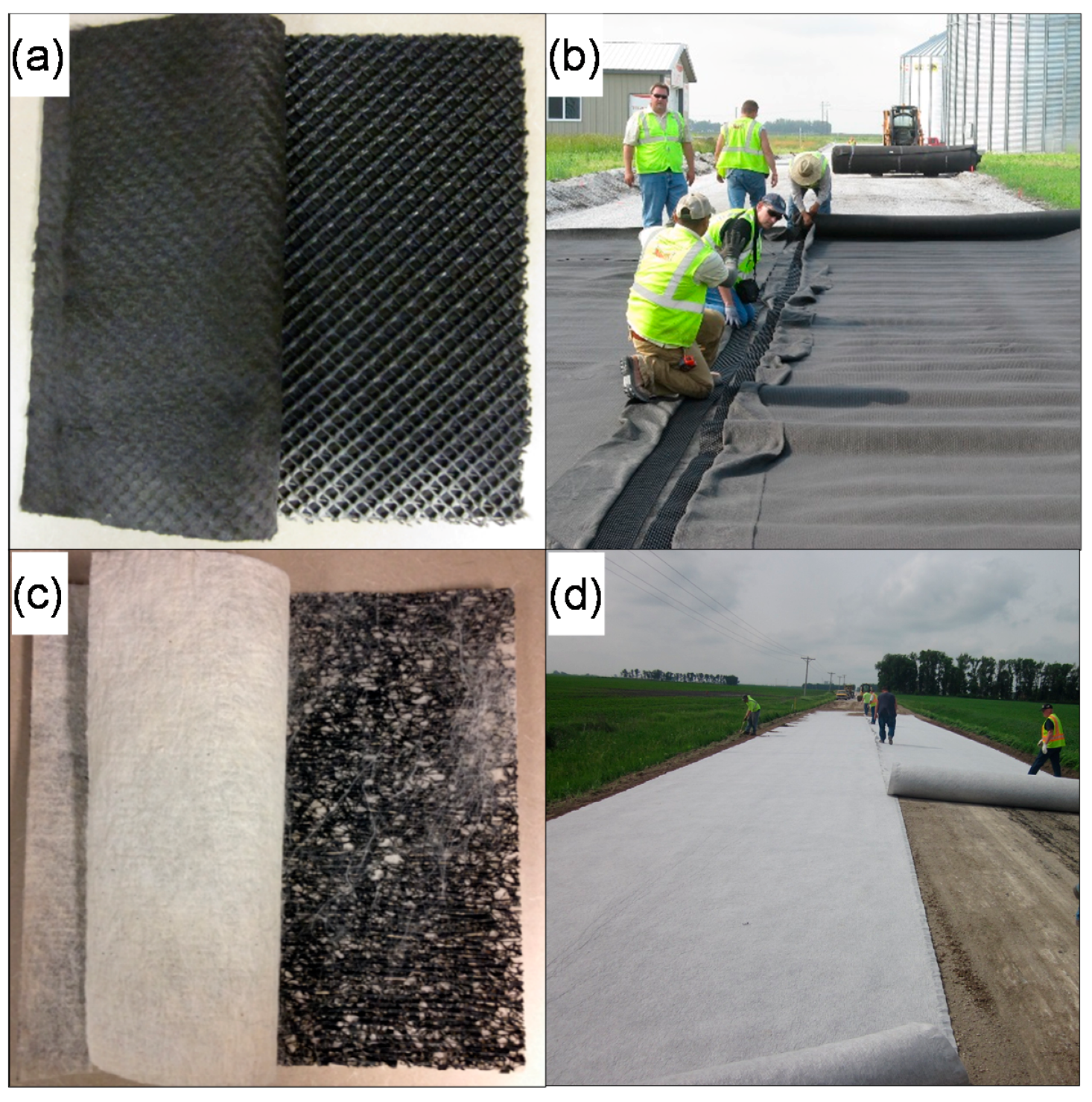
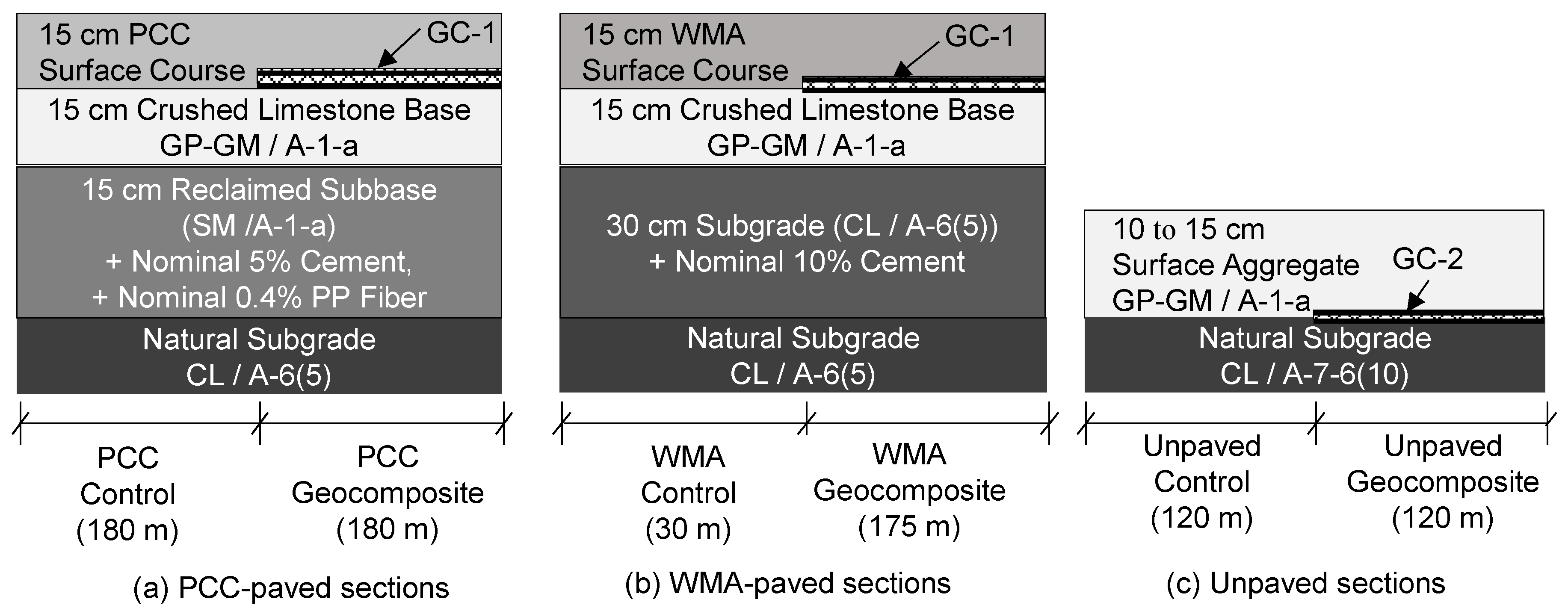
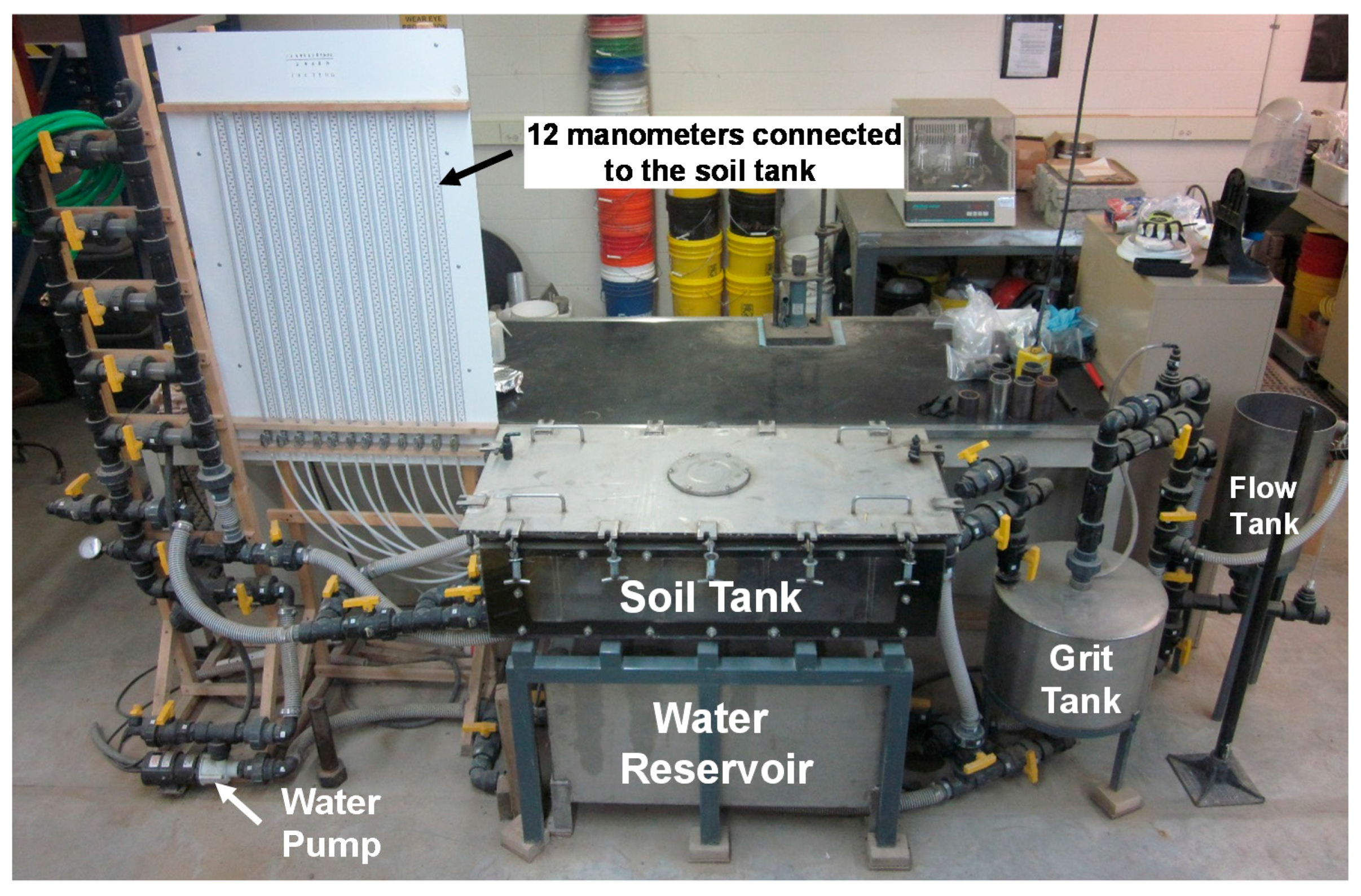
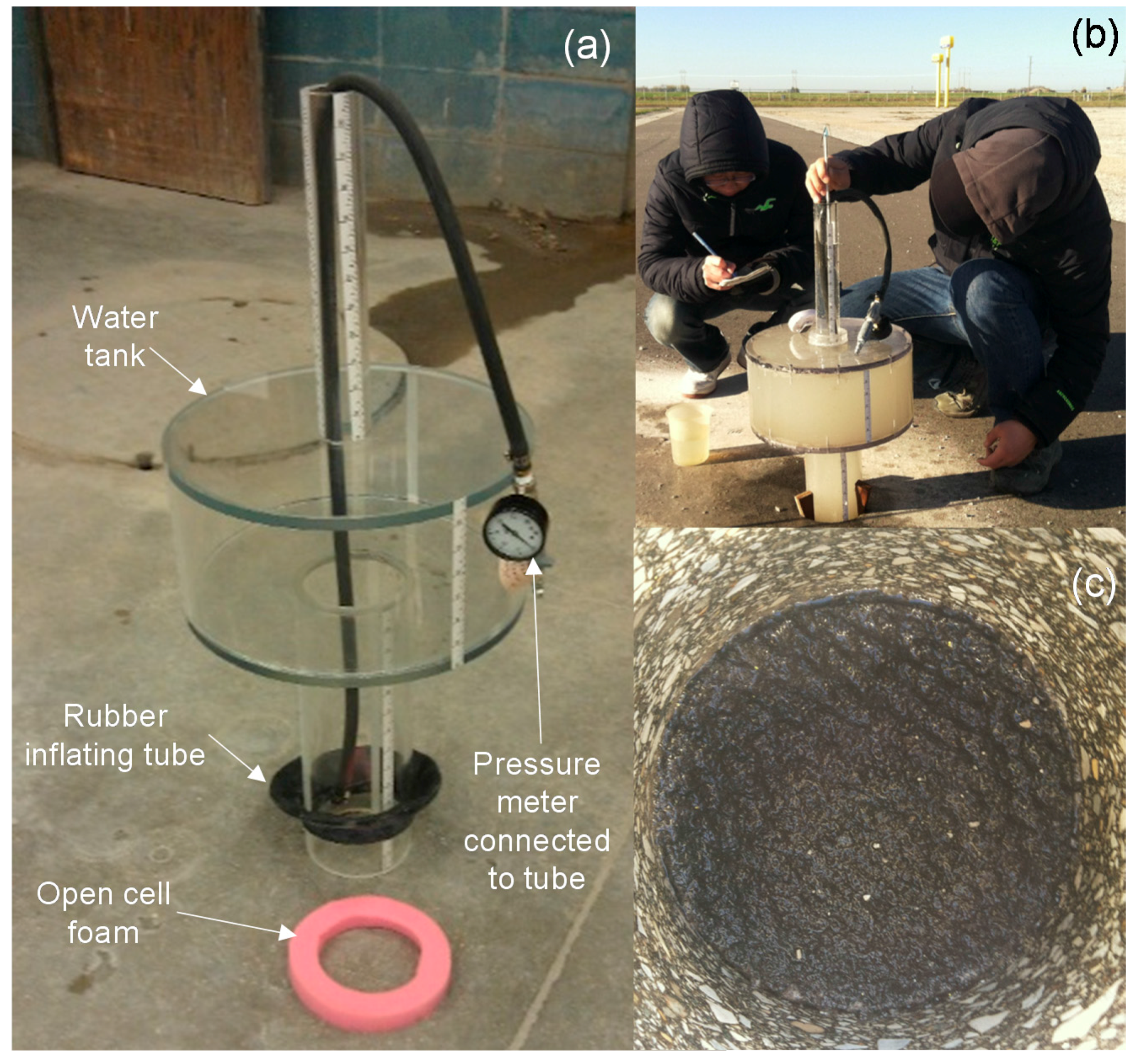
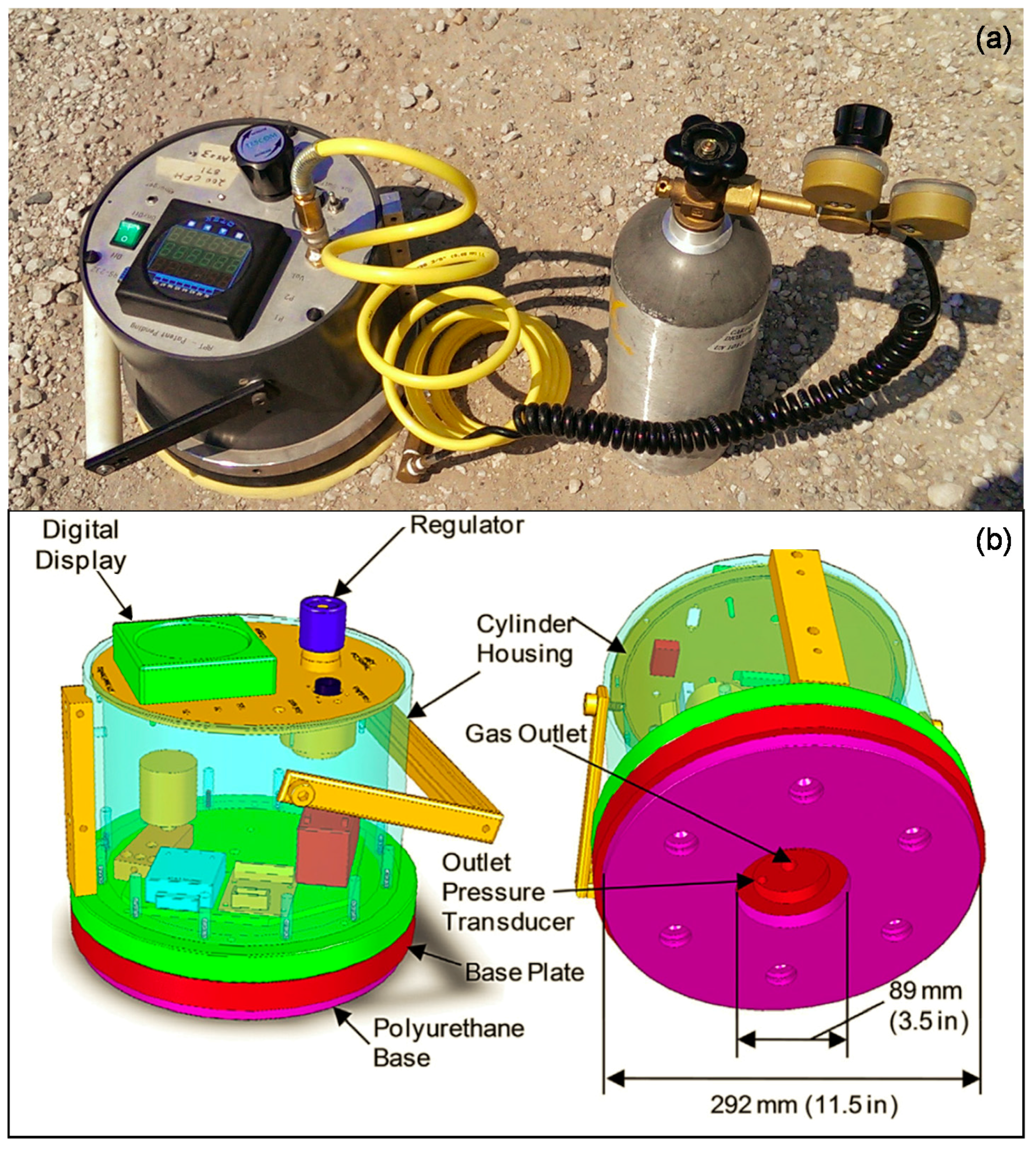
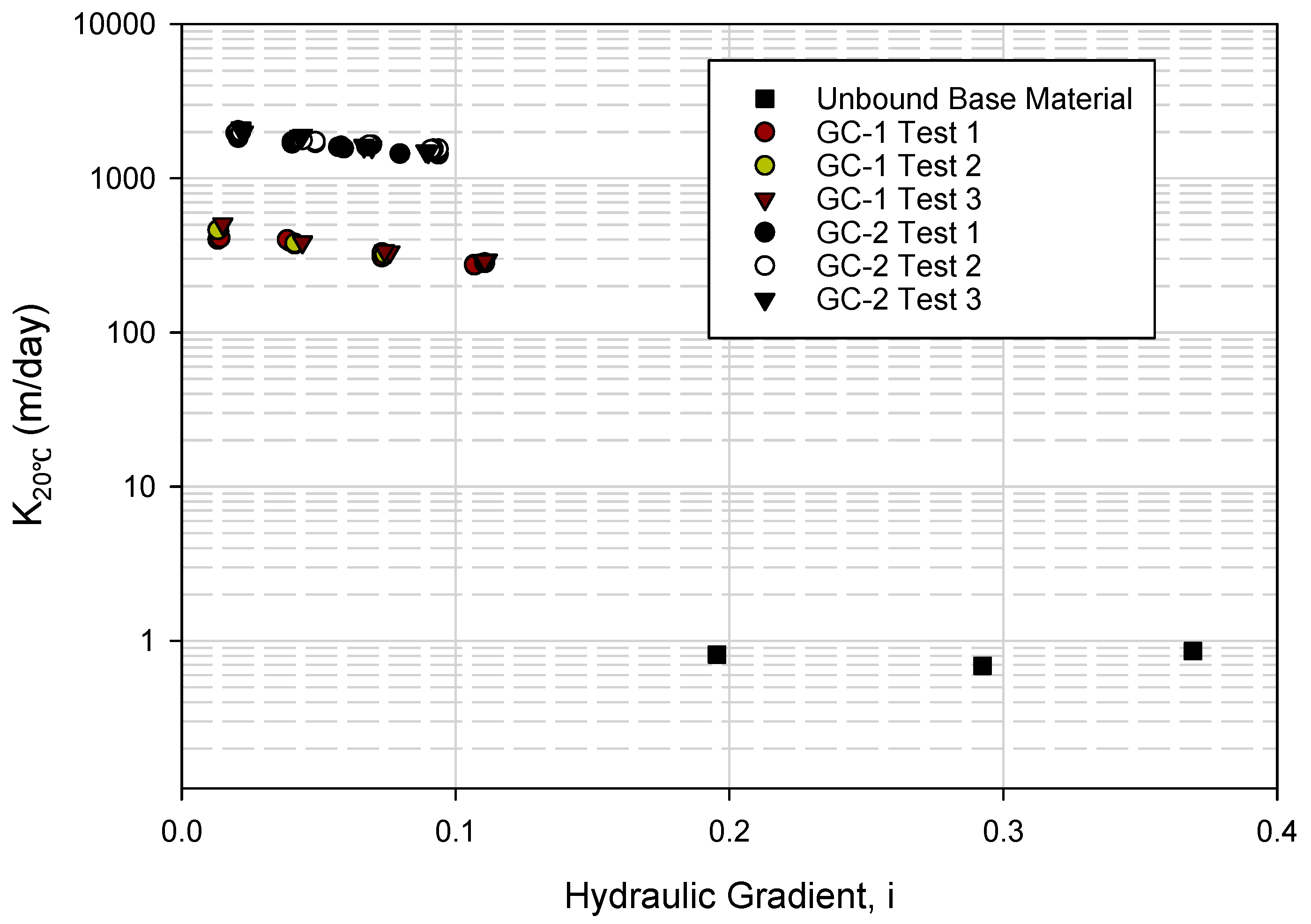

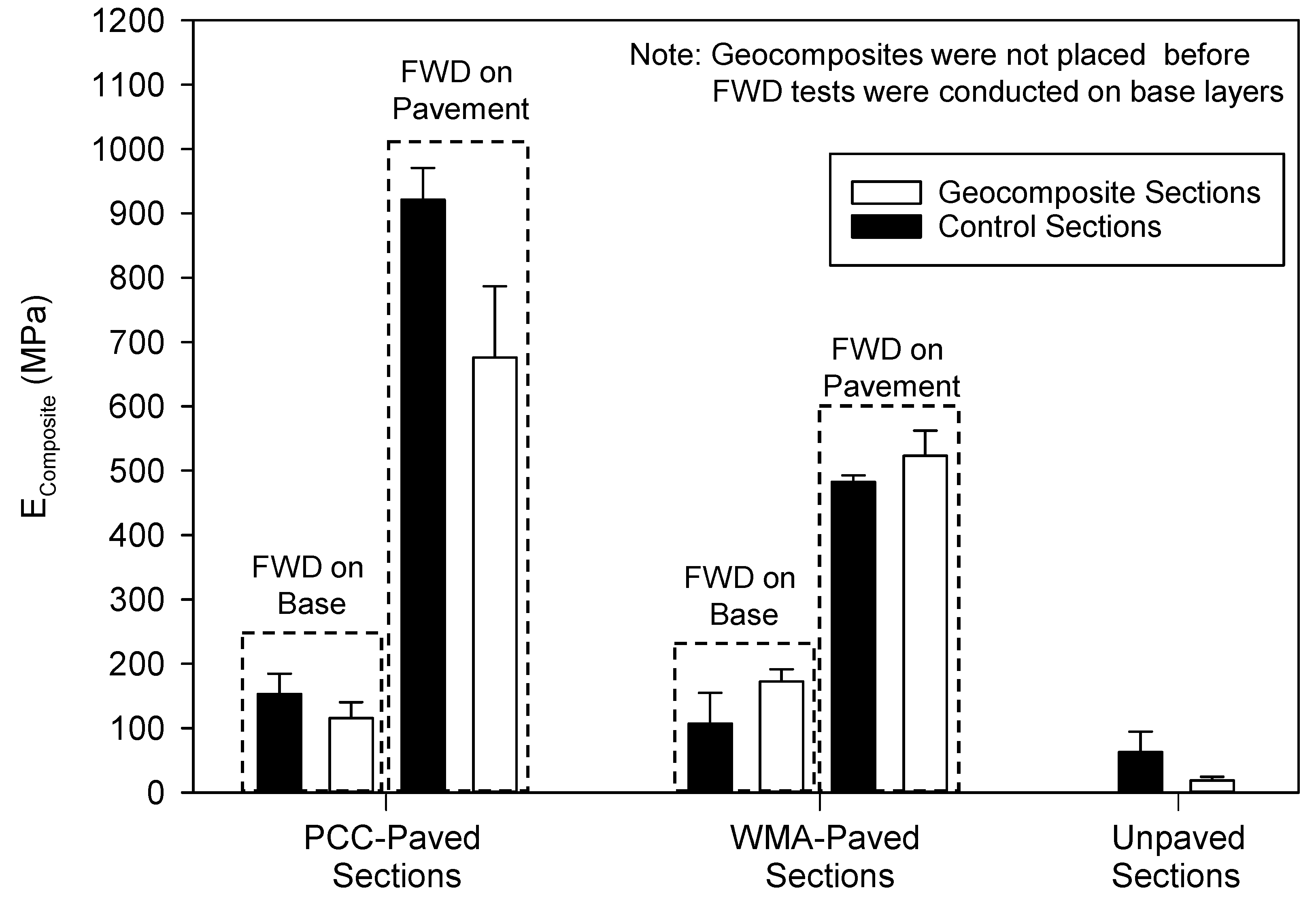
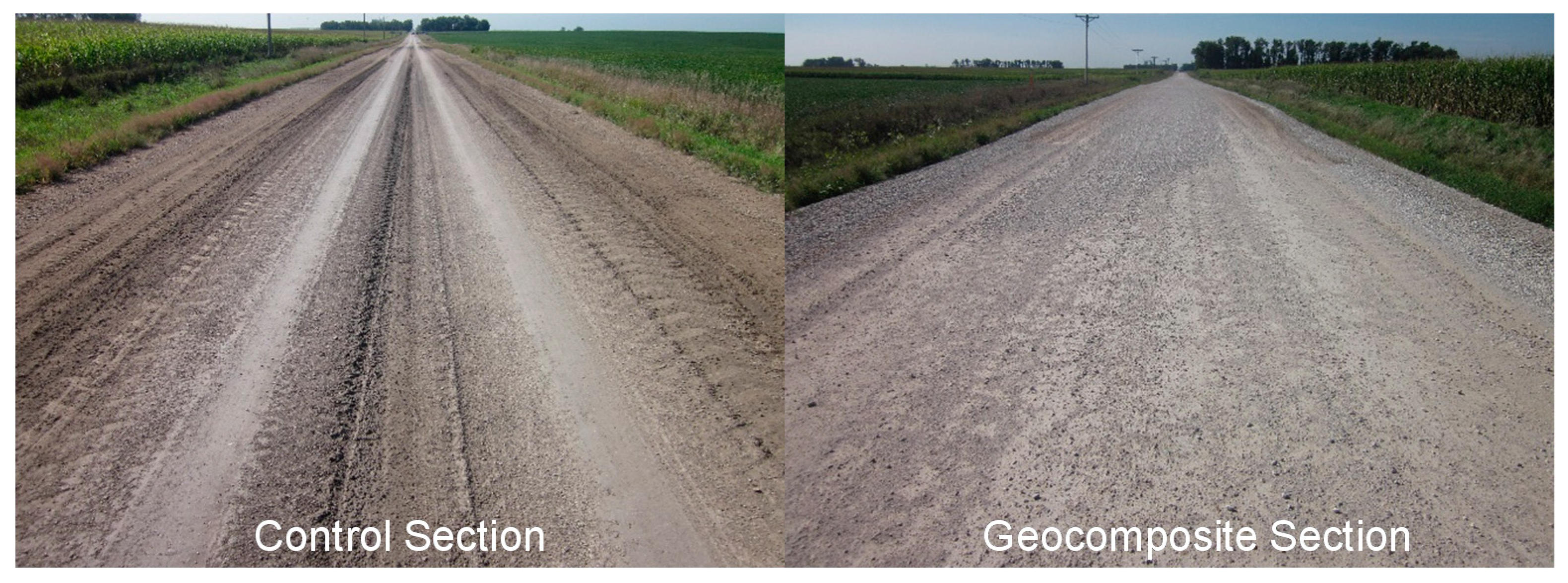
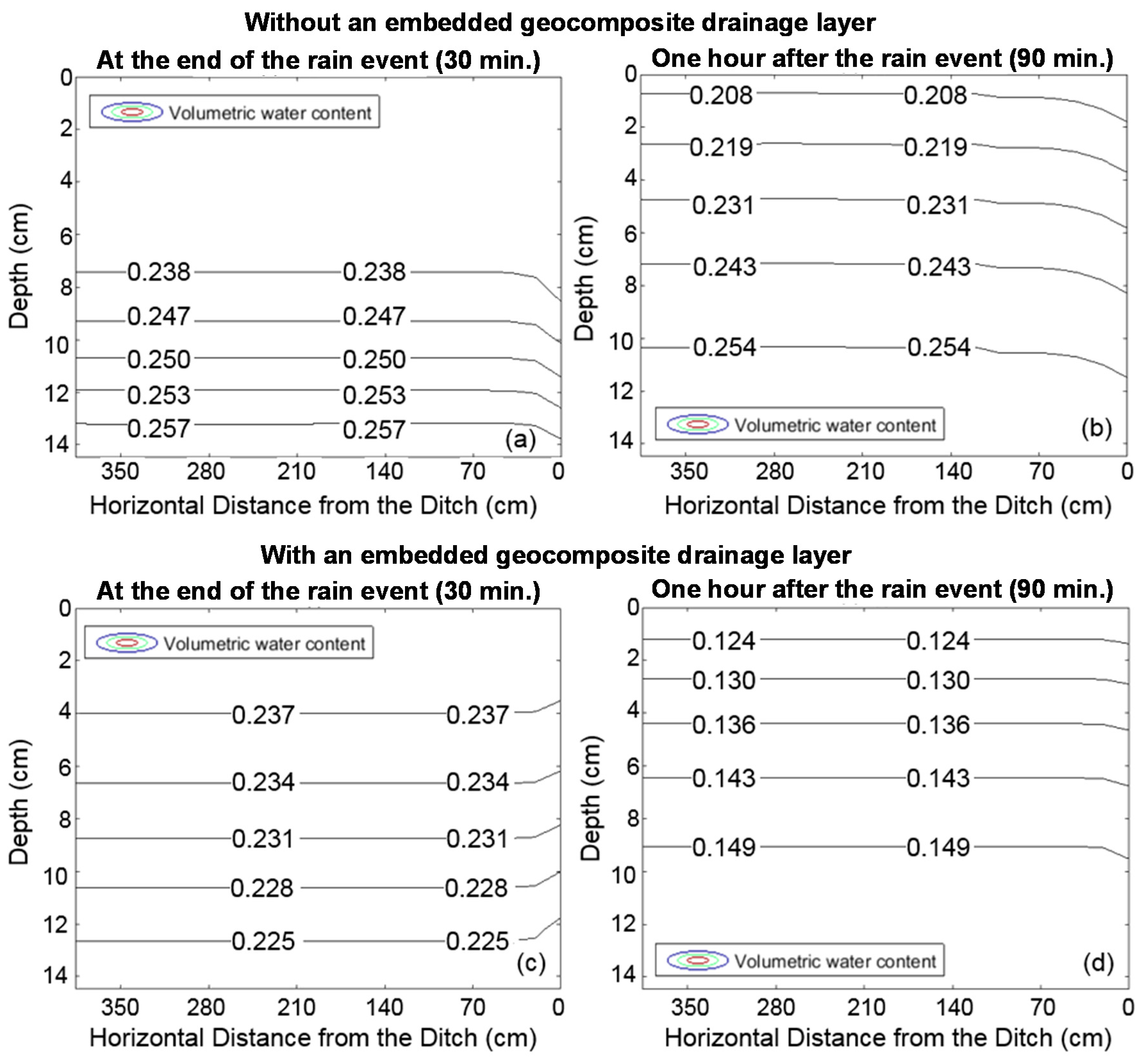
| Property | GC-1 | GC-2 | Testing Method |
|---|---|---|---|
| Thickness (mm) | 11 | 9 | NA (used Calipers) |
| Strength (kN) | Exceeds Class 2 | 17 | AASHTO 2 M 288 [8] for GC-1 ASTM 3 D5035 [9] for GC-2 |
| Water Flow Rate (L/min/m2) | 4481 | 4100 | ASTM D 4491 [10] |
| AOS 1 of the Geotextile (mm) | 0.212 | 0.212 | ASTM D 4751 [11] |
| Parameter | Crushed Limestone Base | Subgrade of Paved Sections | Unpaved Road Surface Aggregate | Subgrade of Unpaved Sections |
|---|---|---|---|---|
| Gravel content (%) (>4.75 mm) | 65.2 | 5.3 | 57.9 | 0.9 |
| Sand content (%) (4.75–0.075 mm) | 27.7 | 39.7 | 30.3 | 39.8 |
| Silt content (%) (4.75–0.005 mm) | 3.9 | 29.3 | 9.2 | 30.6 |
| Clay content (%) (<0.005 mm) | 3.2 | 25.7 | 2.6 | 28.7 |
| D10 (mm) | 0.3 | – | 0.049 | – |
| D30 (mm) | 3.6 | 0.08 | 1.731 | 0.003 |
| D60 (mm) | 10.1 | 0.12 | 9.720 | 0.081 |
| Coefficient of uniformity, cu | 33.7 | – | 198.96 | – |
| Coefficient of curvature, cc | 4.36 | – | 6.31 | – |
| Liquid limit (%) | Non-plastic | 33 | Non-plastic | 43 |
| Plastic limit (%) | 15 | 22 | ||
| AASHTO classification | A-1-a | A-6(5) | A-1-a | A-7-6(10) |
| Unified soil classification system (USCS) group symbol | GP-GM | CL | GP-GM | CL |
| USCS group name | Poorly graded gravel with silt and sand | Sandy lean clay | Poorly graded gravel with silt and sand | Sandy lean clay |
© 2017 by the authors. Licensee MDPI, Basel, Switzerland. This article is an open access article distributed under the terms and conditions of the Creative Commons Attribution (CC BY) license (http://creativecommons.org/licenses/by/4.0/).
Share and Cite
Li, C.; Ashlock, J.; White, D.; Vennapusa, P. Permeability and Stiffness Assessment of Paved and Unpaved Roads with Geocomposite Drainage Layers. Appl. Sci. 2017, 7, 718. https://doi.org/10.3390/app7070718
Li C, Ashlock J, White D, Vennapusa P. Permeability and Stiffness Assessment of Paved and Unpaved Roads with Geocomposite Drainage Layers. Applied Sciences. 2017; 7(7):718. https://doi.org/10.3390/app7070718
Chicago/Turabian StyleLi, Cheng, Jeramy Ashlock, David White, and Pavana Vennapusa. 2017. "Permeability and Stiffness Assessment of Paved and Unpaved Roads with Geocomposite Drainage Layers" Applied Sciences 7, no. 7: 718. https://doi.org/10.3390/app7070718






